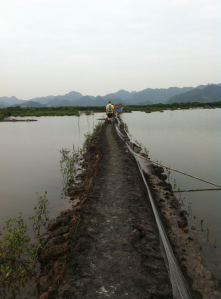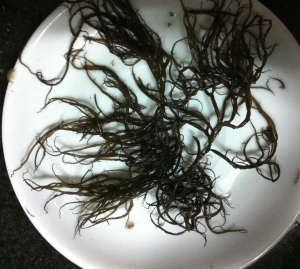Just found the lovely animated series “The Octonauts”.
In short (12 mins) episodes, they present the wonders of the sea in perfect English.
Fun for all, both kids and adults.
This episode of the Octonauts is called “The Great Algae Escape”
Month: November 2014
Trip to Vietnam – looking for seaweeds
When we landed in Hanoi we started with a meeting at MCD, Centre for Marinelife Conservation and Community Development, (more information to be found at http://www.mcdvietnam), where we got coffee and we had a first planning of the work for the following week.

MCD has been a partner to Stockholm University and the Department of Ecology, Environmental and Plant Science in Vietnam for many years. It is mainly women working at MCD and everything is very well-planned and efficient. During our visit we had the opportunity to meet with the local government in Phu Long and get information about the planning of aquaculture in the region for the future. Two master students will together with the help from MCD perform interview with local shrimp and fish farmers as well as trying to find out the use of trash fish in aquacultures, with the aim of proposing development improving the environmental conditions and integrated aquaculture.
 Map of Phu Long
Map of Phu Long
The next day we went to Cat Ba, to study different types of aquaculture activities, ranging from high to low intensity shrimp farming in mangrove plantations, where both fish mainly Tilapia are cultivated in combination with crabs and shrimps.

In the intensive shrimp cultivation 2-3 harvests are produced per year. This type of aquaculture takes up a much smaller area but has a strong impact on the environment while the extensive aquaculture takes up a 10 times larger area and has a less negative impact on the surrounding area and a lower but more diverse production.
 The family lives in the small house located on the edge of the pond.
The family lives in the small house located on the edge of the pond.
Much of the island is part of a UNESCO World Heritage Site and the mangrove is 4000 ha protected. Between 1990- 2000, when aquaculture around the island peaked, 50 hectares of mangroves where cut down. The plan now is to replant mangroves and increasing area and cover.
The mangrove species planted are mainly Rhizophora and Avicennia. They are planted along both sides of the dam. The smallest plants are brand new and the largest over 2 meters in height are about 8 years old.
The second part of our trip was to visit Lan Ha Bay. The area is heavily influenced locally from farms, by untreated sewage from communities around the coast, from harbor construction and from runoff from the Red River, which transports large amounts of sediment, organic matter and nutrients. At the first farm we visited they were feeding the cultivated fish with thrash fish.
Pictures of the on-going sale of trash fish and loading into boxes to be transported to neighbouring fish farms. At one of the fish farms you could stay and have a lunch with really fresh sea-food.
Cultivation of seaweeds seems to be limited in Vietnam. On the road from Phu Long to Cat Ba I suddenly saw some red algae put out to dry along the small road. The algae had been collected form an adjacent pond where they grow naturally. They will get about 1 dollar for 10 kilos or one sac of dried algae (about 70000VDN). It may not be much money, but can still be a contribution to the salary which is around 200 -300 dollar/month.

 Red algae harvest
Red algae harvest
The picture shows women who rakes up dried red algae and put them in sacks so that they can be transported and soled. My first guess on the species was Gracillaria, which I was able to confirm when I found some plants that were not dry.
Picture of Gracillaria spp. from the harvest of dried seaweeds photographed on a small plate at the hotel, since I had forgotten to pack paper for pressing seaweed!
During the visit to the fish farms, while the others were talking to the owner and investigated which fish were cultivated in the various cages and what they were fed, I lay on my knees and looked after what was growing on the edges of the cages and on the nets.
 Cladophora
Cladophora
 Ulva
Ulva
Here are some pictures of the findings! One Cladophora spp., one Ulva spp., looks just like our species on the west coast Ulva lactuca, one Bryopsis spp. and one Polysiphonia spp. The last two species were too small, so I was not able to take any photos.The algae were found only in the innermost fish farms, close to the coast and only down to about 0.5 m depth. Probably because the light conditions in water are so poor that the light is not enough for algal growth. Other species found on the cages were mainly different filter feeders, like sponges and hydroids.
Beautiful red-coloured and finely branched hydroid, looking a bit like Dynamena or Abitenaria. The colour red is produced from a symbiontisk red algae that live inside the animal wall.
Those who had the most beautiful colours were different species of sponges, in colours of maroon, red or clear blue. In one of them was a small crab, who had found good protection inside the sponge. It has been a new experience and I have learned a lot of new things about Vietnam and would very much like to come back and learn more.
 Sunset over the bay – view from our hotel.
Sunset over the bay – view from our hotel.
I will remember the travel to Vietnam for a long time during the dark winter months in Sweden and going to the Askö Laboratory studying the Baltic Fucus.
PhD position on seaweed farming in Sweden
The Department of Biological and Environmental Sciences at Gothenburg University announces a PhD-position on macroalgae farming. The lucky winner will be located at Tjärnö Marinebiological Laboratory, just south of Strömstad on the Swedish west coast. It sounds like really interesting stuff!
Type of employment: Fixed-term employment, four years
Extent: 100 %
Location: Department of Biological and Environmental Sciences, Tjärnö, on the Swedish west coast.
First day of employment: Up on agreement
Reference number: UR 2014/914
Doctoral education
The admission to doctoral education takes place in natural science, specialising in biology. The program comprises four years of fulltime study and includes three years working on a thesis project and one year of courses and literature studies. Courses can be selected within the department/faculty, but national/international courses can also be included. Teaching and supervision of undergraduate students may be included, which extends the doctoral education period.
Project description
The PhD project is part of the larger research project “Sustainable large-scale cultivation of seaweeds in Sweden” where researchers from the University of Gothenburg, the KTH Royal Institute of Technology, and the Scottish Association of Marine Science participate. The overall project objective is to develop a sustainable large-scale system for growing kelp (Saccharina latissima) at the Swedish west coast. Seaweed cultivation is the fastest growing aquaculture sector globally, but is totally undeveloped in Sweden despite good natural conditions. The project deals with methodological and environmental aspects such as new cultivation techniques, mass production of spores and seedlings, breeding of crop varieties, and effects of seaweed cultivation on the surrounding marine ecosystem.
Job assignments
The main task is to carry out thesis work under supervision, during which the PhD student will develop knowledge and skills in methodology, analytical ability and subject theory. The work tasks include laboratory-based production of seedlings, development of new cultivation techniques for seaweeds in the field, development of high-performing lines through breeding, and evaluation of positive and negative environmental effects of large-scale algal cultivation. The studies will be conducted both in the field and in the laboratory.
The thesis work also includes statistical analyses and compilation of results in scientific papers, leading to the publication of a doctoral thesis. The PhD student will also present results at conferences, seminars, and project meetings and is expected to communicate and collaborate actively with other participants.
The admission to doctoral education takes place in Natural Science, specialising in Biology. The program comprises four years of fulltime study and includes three years working on a thesis project and one year of courses and literature studies. Courses can be selected within the department/faculty, but national/international courses can also be included. Teaching and supervision of undergraduate students may be included, which extends the doctoral education period.
For more information on the position, check THIS LINK
You can also contact
Henrik Pavia, +46(0)31-7869685, henrik.pavia@bioenv.gu.se
or
Head of department: Ingela Dahllöf, +46 (0)31 786 3393, ingela.dahllof@bioenv.gu.se
Baltic Flow call for assistance
Within the project ‘BalticFlows’, they are disseminating an online questionnaire to estimate the citizen interest in a water monitoring programme (using simple devices, maintain them and read out and distribute data) within the Baltic Region.
If you can think of an institution, or know people who would like to participate in this questionnaire, please use and distribute the following links (Click on appropriate country):
Germany
Estonia
Finland
Latvia
Sweden

Photo from http://www.balticflows.ec







 Delicious red crabs
Delicious red crabs





